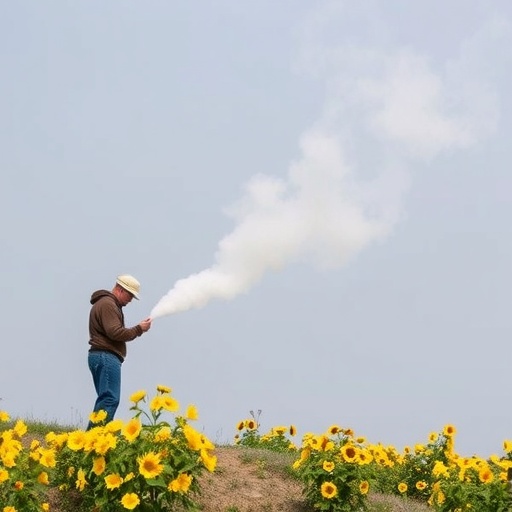New Research Reveals Astounding Link Between Seasonal Allergies and Suicide Risk
While the common garden-variety symptoms of seasonal allergies—sneezing, watery eyes, and relentless itching—are familiar to millions, a groundbreaking University of Michigan study has uncovered an alarming, less obvious consequence: elevated suicide risk during high pollen seasons. This study reveals that beyond mere physical discomfort, the physiological reactions triggered by allergies may prompt profound mental health crises, positioning allergy seasons as a critical factor in suicide prevention efforts.
The researchers quantified this impact with striking precision, demonstrating a 7.4% increase in suicide rates correlating with peak pollen levels. This statistical uptick spotlights an insidious multiplier effect, where the physical toll of allergic reactions—such as disrupted sleep and heightened mental distress—translates into deep psychological vulnerability. The study compellingly suggests that the burden of allergies extends far beyond immediate symptoms into the realm of mental health destabilization.
Dr. Joelle Abramowitz, associate research scientist at the University of Michigan’s Institute for Social Research, emphasizes the complexity of pollen exposure. Her team evaluated pollen from diverse sources—trees, grasses, and weeds—ensuring that their findings reflect a comprehensive ecological spectrum of allergenic triggers. “Small environmental shocks can have outsized impacts if an individual is already in a delicate mental state,” Abramowitz explains. This nuanced understanding reframes pollen exposure as an exogenous shock, distinct from internal psychological factors.
Delving deeper, the study parsed pollen concentrations into four stratified tiers, finding a clear dose-response relationship. With incremental increases across categories, suicide risk grew steadily: from a 4.5% rise at the second tier, climbing to a 5.5% boost in the third, and culminating in a striking 7.4% risk surge at the highest recorded exposure level. This gradient underscores the potent biological and psychological interplay triggered by allergic phenomena.
Methodologically, the study harnessed a vast dataset, bridging environmental and health data streams. Drawing from daily pollen counts across 186 counties within 34 metropolitan U.S. regions, researchers linked this environmental information to suicide data from the National Violent Death Reporting System spanning 2006 to 2018. This robust, multi-year dataset lends considerable weight to the conclusions, underscoring the consistency and reliability of the observed associations.
Co-authors Shooshan Danagoulian and Owen Fleming from Wayne State University highlight a critical dimension that has been historically underexplored: the role of transient environmental stressors as immediate catalysts for suicidal behavior. Unlike structural risk factors rooted in socioeconomic or psychological frameworks, pollen-induced allergies represent an abrupt, external challenge—an “exogenous shock”—that can tip vulnerable individuals into crisis.
Over the study’s 12-year window, approximately half a million suicides occurred nationwide. The researchers estimate that pollen exposure contributed to between 900 and 1,200 additional suicides annually, amounting to an estimated 12,000 deaths during the study period. This staggering figure reframes pollen season not only as a public health concern for allergy sufferers but as a pressing mental health crisis with profound societal implications.
Intriguingly, the study also dissects demographic nuances in pollen sensitivity and suicide risk. Individuals with pre-existing mental health conditions or prior psychiatric treatment exhibited an even higher susceptibility, with an 8.6% increase in suicide incidence on peak pollen days. While white men predominantly drove this trend, elevated vulnerability among Black individuals was unexpectedly pronounced, signaling the need for tailored public health interventions addressing racial and social disparities.
The findings echo parallel research from international contexts such as Tokyo and Denmark, suggesting a pervasive, global pattern implicating pollen-related physiological distress in mental health outcomes. This international concordance bolsters confidence in the universality of the link and mandates that future public health frameworks incorporate environmental considerations into suicide prevention strategies worldwide.
Given the impracticality of reducing pollen-producing vegetation at scale, the study advocates focusing on enhanced public awareness and adaptive behaviors. This involves improvements in pollen forecasting accuracy, coupled with proactive dissemination of timely warnings that empower individuals to mitigate exposure. Practical measures such as limiting outdoor activities, donning protective masks, and preemptive antihistamine use could significantly blunt the mental health impact.
Beyond public education, the authors urge a systemic shift within healthcare practices. Primary care providers must be equipped with an awareness of how environmental allergens influence mental well-being. Screening for allergy history and integrating this knowledge into patient mental health assessments could enable more precise, context-sensitive care. Such an approach would facilitate early intervention during high pollen periods, potentially reducing suicide risk among the most vulnerable subpopulations.
Dr. Abramowitz stresses the broader imperative for a heightened collective conscious toward subtle environmental triggers and their effects on mental health. Recognizing the allergy-suicide connection as a critical factor may inspire a new paradigm in preventive healthcare, where seemingly mundane seasonal changes prompt vital conversations about mental resilience and adaptive coping strategies.
The future outlook is sobering. Climate change-driven shifts in pollen season duration and intensity are projected to exacerbate these challenges dramatically. As pollen windows widen and allergen potency escalates, the researchers warn that allergy-associated suicide risks may more than double by century’s end, underscoring an urgent need for climate-conscious public health policy and mental health resource allocation.
This pioneering investigation, published in the Journal of Health Economics, not only expands the scientific understanding of environmental determinants of suicide but also punctuates the complexity of human health, which intricately intertwines biological, psychological, and ecological domains. As the global community grapples with escalating mental health crises, incorporating these fresh insights could be transformative in reshaping prevention and care paradigms.
Subject of Research:
Article Title:
News Publication Date:
Web References:
References:
Image Credits:
Keywords: Health and medicine, Diseases and disorders, Health care, Human health, Medical specialties
Tags: allergy symptoms and mental distresscorrelation between allergies and suicidecritical tipping points in suicide riskecological triggers of allergic reactionsimpact of allergens on psychological well-beingmental health crises during allergy seasonphysiological reactions to pollen exposurepollen levels and mental healthresearch on allergies and mental healthseasonal allergies and suicide risksuicide prevention and environmental factorsUniversity of Michigan allergy study





